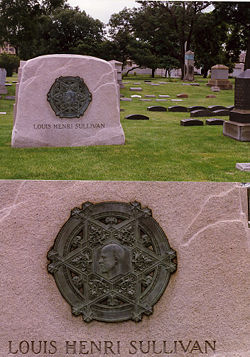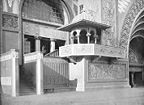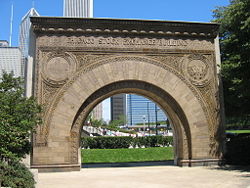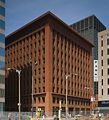Louis Sullivan
Louis Henry (Henri) Sullivan (September 3, 1856–April 14, 1924) was an American architect, called the "father of modernism". He is considered by many as the creator of the modern skyscraper, was an influential architect and critic of the Chicago School, and was a mentor to Frank Lloyd Wright.
Biography
Louis Sullivan[1] was born in Boston, to an Irish-born father and a Swiss-born mother both of whom had emigrated to the United States in the late 1840s. While attending high school Sullivan met Moses Woolson, whose teachings made a lasting impression on him, and nurtured him until his death. After graduating from high school, Sullivan studied architecture briefly at the Massachusetts Institute of Technology. Learning that he could both graduate from high school a year early and pass up the first two years at the Massachusetts Institute of Technology by passing a series of examinations, Sullivan entered MIT at the age of 16. After one year of study, he moved to Philadelphia and talked himself into a job with architect Frank Furness.
The Depression of 1873 dried up much of Furness’s work, and he was forced to let Sullivan go. At that point Sullivan moved on to Chicago in 1873 to take part in the building boom following the Great Chicago Fire of 1871. He worked for William LeBaron Jenney, the architect often credited with erecting the first steel-frame building. After less than a year with Jenney, Sullivan moved to Paris and studied at the École des Beaux-Arts for a year. Renaissance art inspired Sullivan’s mind, and he was influenced to direct his architecture to emulating Michelangelo's spirit of creation rather than replicating the styles of earlier periods. He returned to Chicago, not yet 18 years old. He began work for the firm of Joseph S. Johnston & John Edelman as a draftsman. Johnston & Edleman were commissioned for interior design of the Moody Tabernacle, which was completed by Sullivan.[1] In 1879 Dankmar Adler hired Sullivan; a year later, he became a partner in the firm. This marked the beginning of Sullivan's most productive years.
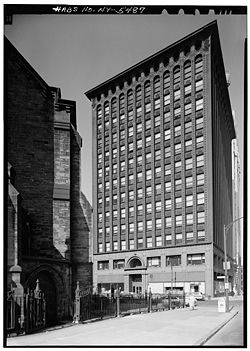
With a string of triumphs such as the 1889 Auditorium Building in Chicago (where Adler and Sullivan reserved the top floor of the tower for their own atelier), the 1891 Wainwright Building in St. Louis and the 1899 Carson Pirie Scott Department Store on State Street in Chicago, Louis Sullivan was the first architect to find the right form for a steel high-rise. Louis Sullivan is credited with coining the phrase "form follows function". The steel girder was the form for the steel high-rise. This new way of constructing buildings pushed them up rather than out. The steel frame allowed taller buildings with larger windows, which meant more interior daylighting, and more usable floor space. The technical limits of masonry had always imposed formal constraints; those constraints were suddenly gone. None of the historical precedents were any help, and this new freedom created a kind of technical and stylistic crisis.
Sullivan was the first to cope with that crisis. He addressed it by embracing the changes that came with the steel frame, creating a grammar of form for the high rise (base, shaft, and pediment), simplifying the appearance of the building by using ornament selectively, breaking away from historical styles, using his own intricate flora designs, in vertical bands, to draw the eye upwards and emphasize the building's verticality, and relating the shape of the building to its purpose. All this was revolutionary, appealingly honest, and commercially successful.
In 1890 Sullivan was one of the ten architects, five from the Eastern US and five from the Western US, chosen to build a major structure for the "White City", the World's Columbian Exposition, held in Chicago in 1893. Sullivan's massive Transportation Building and huge arched "Golden Door" stood out as the only forward-looking design in a sea of Beaux-Arts historical copies, and the only gorgeously multicolored facade in the White City. Sullivan and fair director Daniel Burnham were vocal about their displeasure with each other. Sullivan was later (1922) to claim that the fair set the course of American architecture back "for half a century from its date, if not longer." (Autobiography of an Idea, p. 325) His was the only building to receive extensive recognition outside America, receiving three medals from the Union Centrale des Arts Decoratifs the following year.
Adler and Sullivan broke their partnership after the Guaranty Building. By both temperament and connections, Adler had always been the one who brought in new business to the patnership, and after the rupture Sullivan went into a twenty-year-long financial and emotional decline, beset by a shortage of commissions, chronic financial problems and alcoholism. He obtained a few commissions for small-town Midwestern banks (see below), wrote books, and in 1922 appeared as a critic of Raymond Hood's winning entry for the Tribune Tower competition, a steel-frame tower dressed in Gothic stonework that Sullivan found a shameful piece of historicism. He and his former understudy Frank Lloyd Wright reconciled in time for Wright to help fund Sullivan's funeral after he died, poor and alone, in a Chicago hotel room. A modest headstone marks his final resting spot in Graceland Cemetery in Chicago's Uptown neighborhood. A monument (shown) was later erected in his honor, a few feet from his headstone.
Sullivan's legacy is contradictory. He is the first modernist. His stripped-down, technology-driven, forward-looking designs clearly anticipate the issues and solutions of Modernism. In his last years, Sullivan seemed willing to abandon ornament altogether in favor of honest massing. But to experience Sullivan's built work is to experience the irresistible appeal of his incredible designs, the vertical bands on the Wainwright Building, the burst of welcoming Art Nouveau ironwork on the corner entrance of the Carson Pirie Scott store, the (lost) terra cotta griffins and porthole windows on the Union Trust building, the white angels of the Bayard Building. Except for some designs by his long time draftsman George Grant Elmslie, and the occasional tribute to Sullivan such as Schmidt, Garden & Martin's First National Bank in Pueblo, Colorado (built across the street from Adler and Sullivan's Pueblo Opera House), his style is unique. A visit to the preserved Chicago Stock Exchange trading floor, now at The Art Institute of Chicago, is proof of the immediate and visceral power of the ornament that he used so selectively. Original drawings and other archival materials from Sullivan are held by The Art Institute of Chicago and by the Drawings and Archives Department in the Avery Architectural and Fine Arts Library at Columbia University. Fragments of Sullivan buildings are also held in many fine art and design museums around the world.
Preservation
During the postwar era of urban renewal, Sullivan's works fell into disfavor, and many were demolished. In the 70's growing public concern for these buildings finally resulted in many being saved. The most vocal voice was Richard Nickel, who even held one-man protests of demolitions. Nickel and others sometimes rescued decorative elements from condemned buildings, sneaking in during demolition. This practice led to Nickel's death inside Sullivan's Stock Exchange building, when a floor above him collapsed.
Selected projects
Buildings through 1895 are by Adler & Sullivan.
- Martin Ryerson Tomb, Graceland Cemetery, Chicago (1887)
- Auditorium Building, Chicago (1889)
- Carrie Eliza Getty Tomb, Graceland Cemetery, Chicago (1890)
- Wainwright Building, St. Louis (1890)
- Charlotte Dickson Wainwright Tomb, Bellefontaine Cemetery, St. Louis (1892)
- Union Trust Building (now 705 Olive), St. Louis (1893; street-level ornament heavily altered 1924)
- Guaranty Building (formerly Prudential Building), Buffalo (1894)
- Bayard Building, (now Bayard-Condict Building), 65–69 Bleecker Street, New York City (1898). Sullivan's only building in New York, with a glazed terra cotta curtain wall expressing the steel structure behind it.
- Carson Pirie Scott store, Chicago (1899)
- Van Allen Building, Clinton, Iowa (1914)
- Krause Music Store, Chicago (final commission 1922)
The banks
By the end of the first decade of the 20th century, Sullivan's star was well on the descent and for the remainder of his life his output consisted primarily of a series of small bank and commercial buildings in the Midwest. Yet a look at these buildings clearly reveals that Sullivan's muse had not abandoned him. When the director of a bank that was considering hiring him asked Sullivan why they should engage him at a cost higher than the bids received for a conventional Neo-Classic styled building from other architects, Sullivan is reported to have replied, "A thousand architects could design those buildings. Only I can design this one." He got the job. Today these commissions are collectively referred to as Sullivan's "Jewel Boxes." All are still standing.
- National Farmer's Bank, Owatonna, Minnesota (1908)
- Peoples Savings Bank, Cedar Rapids, Iowa (1912)
- Henry Adams Building, Algona, Iowa (1913)
- Merchants' National Bank, Grinnell, Iowa (1914)
- Home Building Association Company, Newark, Ohio (1914)
- Purdue State Bank, West Lafayette, Indiana (1914)
- Thrift Building (Peoples Saving and Loan Association), Sidney, Ohio (1918)
- Farmers and Merchants Bank, Columbus, Wisconsin (1919)
Lost Sullivans
- Grand Opera House, Chicago. 1880–1927
- Pueblo Opera House, Pueblo, Colorado. 1890–1922. Destroyed by fire.
- Chicago Stock Exchange Building. Adler & Sullivan. 1893–1972
- The Trading Room from the Stock Exchange was removed intact prior to the building's demolition and was subsequently restored in the Art Institute of Chicago in 1977; the entryway arch (seen at right) stands outside on the northeast corner of the AIC site.
- Zion Temple, Chicago. 1884–?
- Transportation Building, World's Columbian Exposition, Chicago. Adler & Sullivan. 1893–94. An exposition building, it was only built to last a year.
- Louis Sullivan Bungalow, destroyed in Hurricane Katrina. Frank Lloyd Wright also claimed credit for the design.
- Schiller Building (later Garrick Theater), Chicago. Adler & Sullivan. 1891–1961.
- Third McVickers Theater, Chicago. Adler & Sullivan. 1883?–1922.
- Thirty-Ninth Street Passenger Station, Chicago. Adler & Sullivan. 1886–1934.
- Standard Club, Chicago. Adler & Sullivan. 1888–1910.
- Pilgrim Baptist Church. Adler & Sullivan. 1891–2006. Destroyed by fire, Jan. 6.
- Wirt Dexter Building. Adler & Sullivan. 1887–2006. Destroyed by fire, Oct. 24.
- George Harvey House. Adler & Sullivan. 1888–2006. Destroyed by fire, Nov. 4.
Images
- Louis Sullivan - cornice detail - Wainwright Building, Seventh + Chestnut Streets, Saint Louis, St. Louis City County, MO.jpg
Wainwright Building cornice
- LSWainrightbldg2.jpg
Wainwright Building detail
- Carsons, Pirie, Scott & Co. Building.gif
Carson Pirie Scott store
- July 18, 2005 249.JPG
The Van Allen Building
- Gage Buildings - Chicago, Illinois.jpg
Gage Building (on right)
- Louis Sullivan - exterior - Holy Trinity Russian & Greek Orthodox Church, 1121 North Leavitt Street, Chicago, Cook County, IL.jpg
Holy Trinity Russian & Greek Orthodox Church, exterior
- Louis Sullivan - interior - Holy Trinity Russian & Greek Orthodox Church, 1121 North Leavitt Street, Chicago, Cook County, IL.jpg
Holy Trinity Russian & Greek Orthodox Church, interior
- Louis Sullivan - Merchants' National Bank, Northwest corner of Fourth Avenue & Broad Street, Grinnell, Poweshiek County, IA.jpg
Merchants' National Bank
Notes
- ↑ Hugh Morrison, Louis Sullivan: Prophet of Modern Architecture (New York: Norton, 1998), 2.
Sources
- Columbian Gallery – A Portfolio of Photographs of the World’s Fair, The Werner Company, Chicago, IL, 1894.
- Condit, Carl W., The Chicago School of Architecture, University of Chicago Press, Chicago, IL, 1964.
- Connely, Willard, Louis Sullivan as He Lived, Horizon Press, Inc., NY, 1960.
- Engelbrecht, Lloyd C., "Adler and Sullivan’s Pueblo Opera House: City Status for a New Town in the Rockies", The Art Bulletin, Published by the College Art Association of America, June 1985.
- Gebhard, David, in Journal of the Society of Architectural Historians, May 1960.
- Morrison, Hugh, Louis Sullivan – Prophet of Modern Architecture, W.W. Norton & Co., Inc. New York City, 1963.
- Sullivan, Louis, The Autobiography of an Idea, Press of the American institute of Architects, Inc., New York City, 1924.
- Sullivan, Louis, Kindergarten Chats and Other Writings, Dover Publications, Inc., New York City, 1979.
- Sullivan, Louis H. Louis Sullivan: The Public Papers Ed. Robert Twombly, Chicago University Press, Chicago & London, 1988
- Thomas, Cohen and Lewis, Frank Furness – The Complete Works, Princeton Architectural Press, New York City, 1991.
- Twombly, Robert, Louis Sullivan – His Life and Work, Elizabeth Sifton Books, New York City, 1986.
- Vinci, John, The Art Institute of Chicago: The Stock Exchange Trading Room, The Art Institute of Chicago, 1977.
- Weingarden, Lauren S. "Louis H. Sullivan: A System of Architectural Ornament" [1924]. Co-published by the Art Institute of Chicago and Ernst Wasmuth Verlag (Germany); distributed by Rizzoli International (U.S.), Wasmuth (Germany), Mardaga (France), 1990.
- Weingarden, Lauren S. "Louis H. Sullivan: The Banks". Cambridge, Mass.: MIT Press, 1987.
External links
- Lieber-Meister - The Louis Sullivan Page
- Sullivan at 150 - extensive list and photos
- Tribute to Louis Sullivan - 150 Years
- Article on fragments of Adler and Sullivan Buildings in Chicago
- Louis Sullivan at the Open Directory Project
Credits
New World Encyclopedia writers and editors rewrote and completed the Wikipedia article in accordance with New World Encyclopedia standards. This article abides by terms of the Creative Commons CC-by-sa 3.0 License (CC-by-sa), which may be used and disseminated with proper attribution. Credit is due under the terms of this license that can reference both the New World Encyclopedia contributors and the selfless volunteer contributors of the Wikimedia Foundation. To cite this article click here for a list of acceptable citing formats.The history of earlier contributions by wikipedians is accessible to researchers here:
The history of this article since it was imported to New World Encyclopedia:
Note: Some restrictions may apply to use of individual images which are separately licensed.

